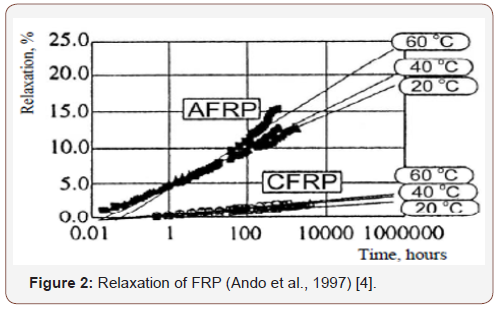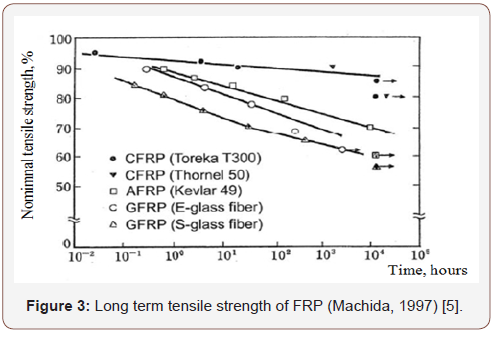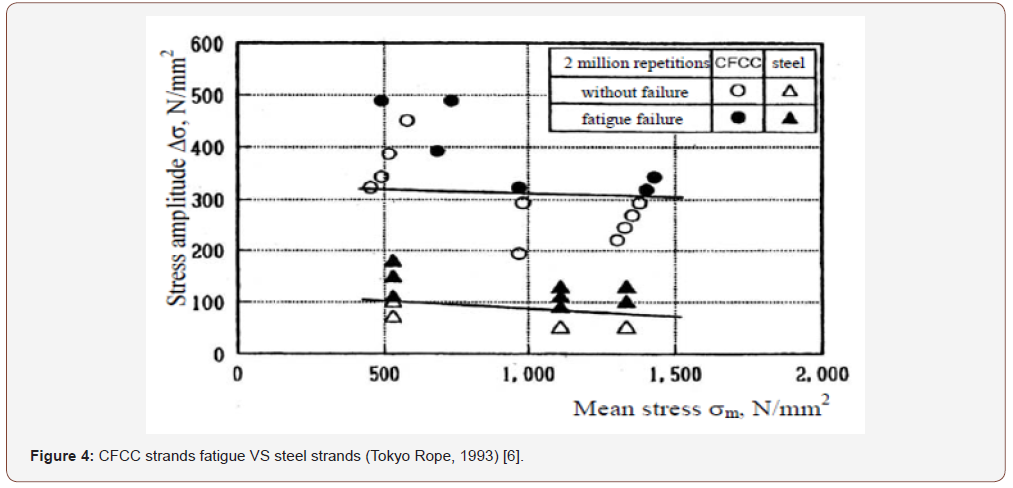 Mini Review
Mini Review
Overview on FRB Pre-Stressed Tendons and its Fatigue Behavior
Ahmed I Hassanin, Faculty of Engineering, Egyptian Russian University, Cairo, Egypt.
Received Date: March 07, 2019; Published Date: May 28, 2019
Abstract
Due to population growth and development of industry and transportation, the environment of human is started to become considerably polluted. Aggressive atmosphere and ground water increase the risk of corrosion of embedded reinforcement in concrete. The addition of waterproofing materials on concrete surface to minimize the amount of water and air that reaches the steel reinforcements through cracks. But waterproof materials are often expensive and need maintenance several times over the structure’s lifetime. The situation is more dangerous for pre-stressing tendons in pre-stressed bridges, deterioration of highway concrete bridges due to tendon corrosion has been large problem in many countries. Structural engineers dealing with durability of concrete greatly concern about possibilities to improve service life of embedded reinforcements.
Several proposals have been presented so far from the developments of concrete technology to the use of epoxy coated reinforcements; however, these did not always lead to the expected results. Early man was aware of the basic principle that a composite material is greater than the sum of its parts. For example, clay and straw were found to be stronger than clay alone; straw being the fibrous reinforcement and clay being the matrix. Currently, worldwide research is going on to find suitable FRP materials such as FRP reinforcing bars, pre-stressing tendons/strands, plates, and sheets for internally and externally reinforced and pre-stressed concrete structures and to derive best possible structural efficiency in terms of structural strength and life with little maintenance. All the FRP materials have added advantages over the conventional materials, due to its superior strength, stiffness, and durability qualities.
Production Procedures
Although a variety of techniques can be used to manufacture FRP shapes, a technique called pultrusion is used almost exclusively for the manufacture of FRP reinforcing rods. In this technique, continuous strands of the fibres are drawn from creels (spools of fibres) through a resin tank, where they are saturated with resin, pulled through several wiper rings, and finally pulled through a heated die. This process simultaneously forms, and heat cures the FRP into a reinforcing rod. To ensure a strong bond with concrete, a surface treatment is applied consisting of a spiral, or a braided wrap, or a coating of sand embedded in the outer surface of the polymer matrix [1]. The pultrusion process is illustrated schematically at (Figure 1).

Background About FRP
The first used type of fiber reinforced polyester composites was a glass and used in the aircraft industry during the 1940s. This was followed some years later by the first non-military application in the marine sector, where FRP proved a complete innovation – revolutionizing the way boats were built. Idea of using glass fiber as reinforcement instead of steel in concrete structures has already appeared in the 1950s, beam tests were also carried out [2]. These trials were unsuccessful, because glass fiber reinforcements available at that time had a bad bond performance. After a long silent period, use of fiber reinforced polymers as reinforcement appeared again in the 1970. In Germany, Japan and some other countries, main field of research focused on glass fiber reinforced polymer. Bayer AG (Germany) produced the first commercially available non-corrosive pre-stressing tendon, with the brand name Polystal HLV (Hochleistung-Verbundstab). Supplier developed the full prestressing system with the use of glass fiber reinforced polymer tendons and anchoring devices. Applicability of the new material was investigated on full-scale experiments. The first bridge application – a prestressed concrete bridge – was constructed at 1980s, in Düsseldorf. In the next few years another three bridges were constructed with Polystal in Germany. Then several experimental and full-scale applications could be found all over the world of glass fiber reinforced polymer reinforcement in bridges (Sweden, Soviet Union, Japan, USA, etc.). However, the widespread use stopped due to the simple fact, that ordinary glass fibers were not alkaline resistant enough, therefore, suffered considerable deterioration in the alkaline environment of concrete. The widespread use returns again, when Manufacturers discover a new thing in the glass fibers creation that makes special chemical composition. This thing called (urethane-modified vinylester) that makes the reinforcement alkaline resistant. Manufacturers guarantee the resistance against alkalinity. AS a result of the research work in the 1980s, aramid and carbon fibers were developed. Because of their high price these new fibers were used in the beginning mainly for aerospace research and military purposes (bullet-proof vests). Gradual price reduction made possible civil aircraft, automotive, electronics (loudspeakers) and sport equipment (skis, tennis rackets (applications as well.For civil engineering purposes (reinforcement for concrete structures) the first aramid fiber reinforced polymer bars (FiBRA Technora) and carbon fiber reinforced polymer bars (CFCC, Leadline) were produced in Japan. Highest quantities of these reinforcements are still produced in Japan. In Europe producers can be found in Italy (Arapree, Carbopree) or in The Netherlands (Carbon-Stress). Main advantages of aramid and carbon fibers besides their high tensile strength their excellent fatigue strength and resistance to all kinds of aggressive environments. In North America, Japan and Europe more and more new bridges are constructed with non-metallic reinforcements. With increasing experiences of these alternative applications, the use of FRPs – mainly CFRP – can spread in addition to probably more price reductions. During the 1990’s, several demonstration projects in Canada showed the potential of FRP applications. In 1993, the Beddington Trail Bridge was built in Calgary, Alberta using FRP pre-tensioned tendons and incorporating fiber optic sensors for ongoing structural health monitoring [3]. This was the first bridge of its kind in North America, and one of the first in the world. A second bridge, Taylor Bridge, incorporating FRP pre-stressing tendons was built at Headingly, Manitoba in 1997. In the United States, the Bridge Street Bridge in Southfield, Michigan was completed in 2001, and used bonded and un-bonded carbon FRP (CFRP) pre-stressing tendons.
Characteristics and properties of FRP tendons
Fiber reinforced polymers are anisotropic composite materials, consisting of high-strength fibers embedded in a light polymer resin matrix. The mechanical properties of an FRP product such as strength and stiffness are highly dependent on: the mechanical properties of the fiber and the matrix, the fiber volume fraction of the composite, the degree of fiber matrix interfacial adhesion, the fiber cross section, quality, and orientation within the matrix, the loading history, duration, environmental conditions, and the method of manufacturing. These factors are interdependent, and consequently it is difficult to determine the specific effect of each factor in isolation.
Relaxation: Further experimental results on the relaxation of several types of fiber strands were made. Relaxation of 3000 hours were investigated at 20, 40 and 60 °C under initial stress level of 0.70 of ultimate stress [4] (Figure 2).


Creep and long-term strength: Dealing with creep of FRP two issues can be defined: one is the strain increment due to creep (Δεf) and the other one is the long-term tensile strength under long term loading. Experimental results on the long-term tensile strength of various FRP reinforcements are given in (Figure 3) [5]. Superior properties of CFRP materials can be observed with long term residual strength after 100 years of more than 90 percent of short-term tensile strength (Figure 3).
Fatigue: Based on the limited data on fatigue tests with CFRP reinforcements it can be stated that fatigue strength of CFRP is much higher than that of conventional steel prestressing materials. Results on CFCC strands are presented in (Figure 4) [6]. In the tests load cycles were repeated until 2 million repetitions and fatigue failures of CFRP as well as control steel strands were recorded. Mean stress and stress amplitude were increased during load history. Horizontal axis in (Figure 4) represents mean stress, while vertical axis represents stress amplitude. Empty marks demonstrate specimens that could carry 2 million repetitions without failure. Filled marks demonstrate specimens of fatigue failure. It can be concluded that fatigue failure of CFCC occurs over 300 N/mm2 of stress amplitude, which is more than 3 times higher than that of control steel strands (Figure 4).

Tensile strength and young’s modulus: Tensile strength and Young’s modulus of FRP reinforcements depend on mainly the type of fibers, the volumetric ratio of fibers (usually more than 60 percent), the angle between load carrying fibers and longitudinal axis of reinforcement, the shape of the cross section of the rebar and diameter of the reinforcement (Table 1)[7].
Table 1: Tensile properties of pre-stressing tendons according to (CAN/CSA-S806-02) [7].

Transfer and development lengths
In general, Transfer and Development lengths of FRP tendons could be influenced by [8]:
• Tensile strength.
• Modulus of elasticity.
• Cross-sectional shape.
• Surface preparation (braided deformed, smooth).
• Type and volume of fiber and matrix.
• The method of force transfer.
• Concrete strength and cover (Table 2).
Table 2: Typical transfer and development lengths for FRP tendons (ACI 440.4R-04) [8].

Acknowledgement
None.
Conflict of Interest
No conflict of interest.
References
- JL Clarke (1993) (1st edn) Alternative materials for the reinforced and prestressing of concrete. CRC Press pp.218.
- Ivan A Rubinsky, Andrew Rubinsky (1954) A preliminary investigation of the use of fiber glass-for prestressed concrete Magazine of Concrete Research 6(17): 71-78.
- ISIS Canada Educational Module 5: Introduction to Structural Health Monitoring.
- N Ando, H Matsukawa, M Kawamura, M Fujii, T Miyagawa, et al. (1997) Experimental studies on the long-term tensile properties of FRP tendons. Fracture Mechanics of Concrete Structures 2: 203-208.
- Machida Atsuhiko (1997) Recommendation for design and construction of concrete structures using continuous fiber reinforcing materials. Concrete Libary of JSCE.
- Tokyo Rope Mfg Co Ltd (1993) Technical data on CFCC, Tokyo.
- CSA (2002) Design and construction of building components with fiber-reinforced polymers CSA standard CAN/CSA S806-02. Canadian Standards Association
- R El-Hacha (2011) Prestressing Concrete Structures with FRP Tendons (ACI 440.4R-04).
-
Ahmed I Hassanin. Overview on FRB Pre-Stressed Tendons and its Fatigue Behavior. Mod Concept Material Sci. 1(2): 2019. MCMS. MS.ID.000510.
-
FRP materials, Polymers, Fibers, CFRP reinforcements, Composite materials
-

This work is licensed under a Creative Commons Attribution-NonCommercial 4.0 International License.






